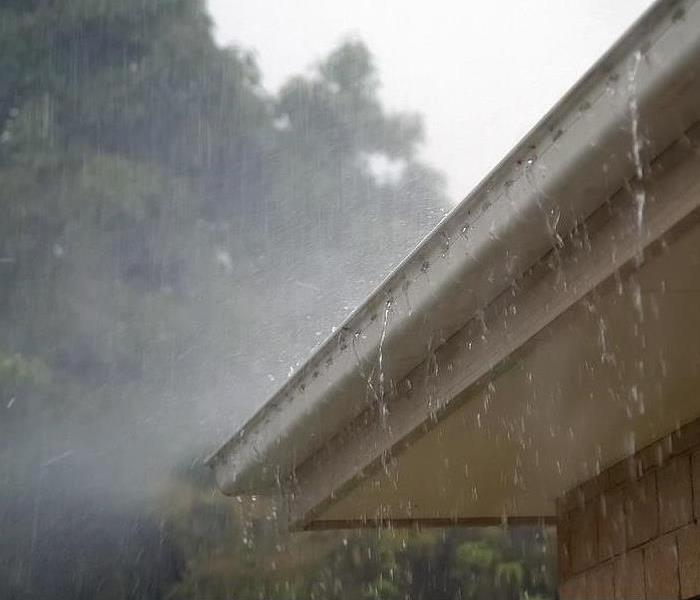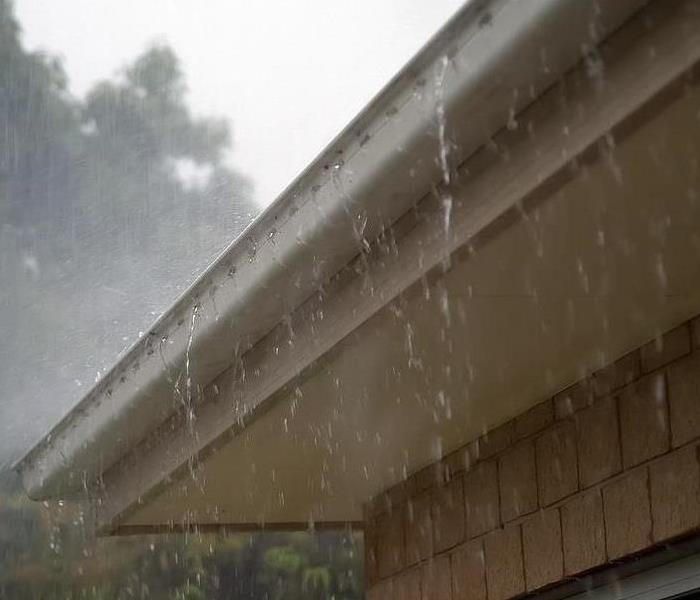Recent Storm Damage Posts
What to Do When Your Home is Flooded
6/6/2022 (Permalink)
 If you don't want your home to look like this, call SERVPRO NoHo for fast flood damage cleanup and restoration service in Los Angeles.
If you don't want your home to look like this, call SERVPRO NoHo for fast flood damage cleanup and restoration service in Los Angeles.
Many homeowners are unhappy when they find out they have water damage in their home. The first step in remediating water damage is to contact SERVPRO of North Hollywood. SERVPRO franchises specialize in water damage restoration, and SERVPRO of North Hollywood has over 15 years' experience in cleaning up and restoring water, fire and mold damage to homes and businesses. In the event of a crawl space, basement or bathroom flood, "SERVPRO NoHo" has the expertise and resources to assist you in drying out your home and getting it back to a livable condition. This post will discuss what you should do if your home is flooded and how to get help from SERVPRO NoHo when you need it.
What’s the first thing you should do if your home is flooded?
First, if it is safe to do so, you should check for the source of the water. If the source is a plumbing leak, you should turn off the main valve and shut off the water. If the source is a rainstorm, there may not be anything you can do to stop the water until the rain stops. But you can cover furniture and valuables with a tarp or waterproof material or move them to a dry place. You can also collect water in buckets and lay down towels to soak up the water and minimize the damage. If possible, you may also want to cut the electricity to the affected area to reduce the risk of a short that can spark a fire.
Do you have flooding insurance?
There are many things to think about when your home suffers water damage from flooding, but one of the first things you’ll need to answer is whether or not your insurance will cover the drying, repair and restoration process. Did you know that flood damage is often not covered by many homeowners’ policies? You often need a separate flooding policy or rider. On the other hand, so long as the damage isn’t a result of your negligence and is considered accidental, your standard homeowner’s insurance policy should cover other types of water damage. But if you’re not sure, a quick call to your insurance provider should be able to answer your question.
P.S. If you’re a renter, we recommend renter’s insurance. Depending on the cause of the damage, your landlord may or may not be liable for replacing your personal property in the event of a flood. While it won’t cover the repairs to any damage the flood causes to the property itself (walls, floors, ceiling etc.), renter’s insurance will help protect you and ensure that your furniture and other possessions can be replaced if necessary.
What should I do if I’m not insured?
Well, frankly, you should be. SERVPRO NoHo highly recommends homeowner’s and/or renter’s coverage for water damage. Indeed, we work directly with insurance to streamline the recovery process. But if you don’t have coverage, you’re at risk of having to pay the entire cost of repairing or replacing your property out of pocket. It’s not uncommon for the water damage restoration process alone to cost upwards of $2,500 depending on the extent of the damage.
That said, if you’re in the middle of a flooding emergency and aren’t sure about your insurance situation, SERVPRO of North Hollywood is here to help you. We’ll come out to your home to inspect, estimate the cost and mitigate the damage. We can work with you on paying the cost to fix the damage and get things back to normal as soon as possible.
When should I call in the professionals?
There are many things that you can do to minimize the water damage and make the clean-up process easier. But many property owners don't realize the severity of the damage and end up waiting too long to call for help. As soon as you are able to stop the flow of water, whether by taking mitigation measures yourself or by calling a local plumber, it’s time to give the professionals of SERVPRO NoHo a call.
Our team is here to help you, 24 hours a day, 7 days a week. We respond quickly and can be on-site to many areas of Los Angeles to assess the damage and begin mitigation measures in as little as one hour. Simply put, SERVPRO is the most trusted name in the restoration industry. Calling (818) 754-0050 is certainly one of the first and best steps you can take to reduce the amount of potential water and mold damage from a flooding emergency!
P.S. Are you a renter? Before calling us, you need to call your landlord or property manager. Legally, we cannot even enter your apartment without their permission. Save yourself some time and headaches and coordinate things with them first.
What can I do to speed up the drying process?
First and foremost, you can move furniture and other possessions away from the affected area. You can also remove standing water with buckets, sponges, towels and anything else that can soak it up. Last, but not least, it can help to increase the air flow by opening doors, windows and running fans.
Of course, water can still seep into places not visible to the eye. Because even a small amount of moisture can trigger mold growth or weaken and damage wood, stone and other foundational materials, it’s still important to make sure the flooded area is completely dried and disinfected. SERVPRO of North Hollywood has the advanced technology, including moisture detection units, industrial air movers, dehumidifiers and chemical disinfectants to ensure that’s the case.
How can I keep my home from flooding in the first place?
There are a number of steps you can take to reduce the risk of flooding in your home. Regular and proper maintenance of your plumbing systems, particularly hot water heaters, pipes under sinks, toilets and sewer systems can help prevent clogs, bursts and overflows.
You can also inspect windows, doors and other areas where rainwater can enter your home. Replace worn weather stripping and caulk and close off those points of entry. You should also look up and check your ceiling and walls for bubbles or water spots that can indicate an impending problem, from rainstorms, leaky air conditioners and pipes and other sources of water entering your home.
Make sure to clear out your rain gutters and downspouts. During those infrequent Los Angeles rains, you’ll want to make sure they’re doing their job directing the water away from your crawl space, basement and foundation.
Last, but not least, consider installing a sump pump, or testing it out if you already have one. Sump pumps are a valuable first line of defense against standing water in your basement, garage or crawl space.
Conclusion: Don’t panic and call SERVPRO NoHo!
Like most homeowners, you may think a flooding disaster will never happen to you. Take our advice and prepare now, because most property owners will experience a flood damage emergency at least once in their lifetime. When it does, don’t panic and call SERVPRO of North Hollywood at (818) 754-0050. We’ll make a water damage disaster “Like it never even happened.”
3 Keys to Effective Disaster Response & Recovery
11/8/2021 (Permalink)
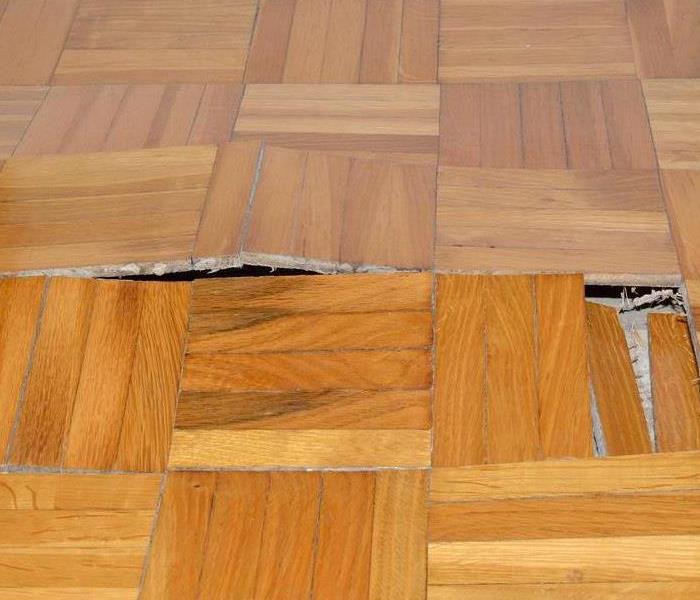 If flood water is left standing for too long, it can cause serious damage. Call SERVPRO of North Hollywood for fast flood damage cleanup & repairs.
If flood water is left standing for too long, it can cause serious damage. Call SERVPRO of North Hollywood for fast flood damage cleanup & repairs.
There are many ways a water disaster can damage your property. The most common are a burst pipe or sewage overflow. An aggressive sprinkler system, leaky water heater or air conditioner could also be culprits. But rainstorms, as infrequent as they are in Los Angeles, can be devastating disasters for an unprepared property owner. To increase the likelihood of restoring your property to its preloss condition, read on for three keys to an effective disaster response and recovery. While the focus of this post is flooding, our advice applies to any disaster, including fire, mold or biohazard cleanup.
1. Be Prepared
Rainstorms in Los Angeles are hardly inevitable. But if one does arrive, you don't want to get caught off-guard. Like Disney advised, "be prepared." How?
First, ensure your flood mitigation measures are in proper working order. Clean out rain gutters and test your sump pump. Diverting the water from your foundation can help prevent your basement or crawl space from flooding.
Inspect your roof and look for broken or missing shingles. Through your roof is a common way water can find its way into your home or business. Look for water spots or discoloration on your ceiling and fix those weak spots before the storms arrive.
This is a good time to check the seals around doors and windows. Worn seals won't allow in a large amount of water, but any moisture can wear wood framing and drywall and spark mold growth.
Last, but not least, review your evacuation plan. Don't have one? Now is as good a time as any to make a plan. It should include resources for emergency alerts, an evacuation route, shelter and contact information for your family or colleagues.
2. Take Mitigation Steps
No matter how well you prepare, effective disaster recovery requires fast action when a disaster occurs. How you respond to an emergency disaster in those first critical minutes and hours can make all the difference.
First, cut the electricity to any area affected by a serious leak or standing water. You can do this from a local circuit breaker or the main electrical switch. Water and electricity don't mix, and you don't want to compound a water disaster with a fire disaster too.
If you can reduce or stop the flow of rain water, do it. Use towels or other absorbent materials to sop up as much water as possible. If the water is confined to a room, move furniture and critical possessions to a drier area.
Does the damaged area, like a broken window or door, make your property accessible to intruders? Consider boarding it up. If you're unsure how, we can help you. Boarding up your property following a disaster can help prevent access and further damage from opportunistic humans and animals.
3. Call SERVPRO of North Hollywood for Disaster Response & Recovery
We're here to help when you need us, 24/7. We provide emergency disaster response support, and can be on-site to most areas of Los Angeles in as little as one hour. An immediate response is critical to an effective cleanup and restoration process. And you can count on SERVPRO of North Hollywood for insurance claims assistance and superior customer service every step of the way. Part of your community and a local restoration leader, with national resources, we'll make any size storm disaster "Like it never even happened."
How do Wildfires Start? What Can You Do to Limit Wildfire Damage?
9/17/2021 (Permalink)
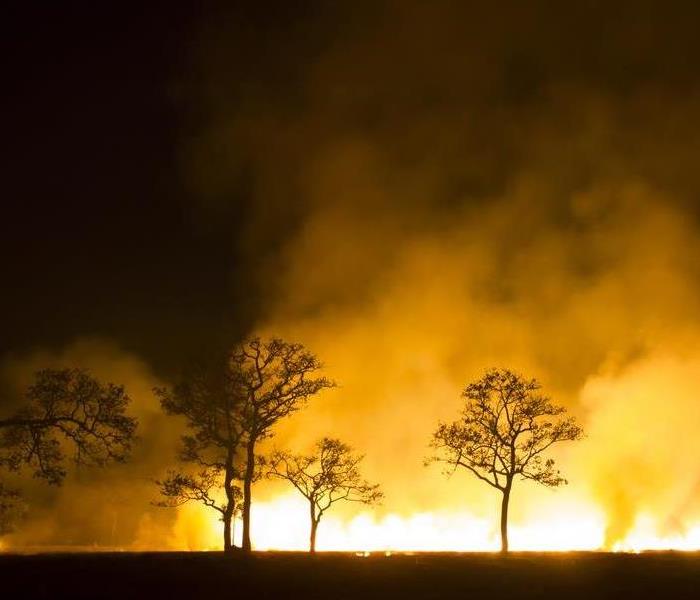 Wildfires can be devastating natural disasters. If you need wildfire damage cleanup for your home or business, call SERVPRO of North Hollywood 24/7.
Wildfires can be devastating natural disasters. If you need wildfire damage cleanup for your home or business, call SERVPRO of North Hollywood 24/7.
Wildfires are devastating fire disasters that can damage houses and commercial buildings and destroy forests. They can be a terrifying experience for any Los Angeles homeowner. And wildfires are getting more frequent and more intense with climate change. They are a regular occurrence across California, since it is one of the drier and warmer states in the country.
What causes these roaring infernos to ignite and burn everything in their path? And what can a responsible resident do to protect their belongings and reduce the risk of fire, smoke and soot damage to their home?
How Do Wildfires Start?
To light and spread, wildfires need three essential components, known as the fire triangle.
1. Heat
Heat sources from nature and human beings can be responsible for igniting a wildfire. Lighting strikes are a frequent source, and they're often larger and spark greater damage than human caused fires. However, humans are mainly responsible for them, accounting for "nearly 85 percent."
A range of human activities drives wildfires. Some examples are:
Campfires – People fail to extinguish fire pits. Or they build fires in dry or inappropriate locations. In both scenarios, sparks from the pit may blow onto leaf litter, setting it on fire.
Power Lines – Wind gusts and car accidents can knock down electricity lines. Those sparking power lines ignite a flame that spreads further with strong winds. Mitigating this risk is one of the reasons California's utilities enact controversial planned blackouts.
Cigarettes – Because it's a hazard to public health, California cities began banning smoking indoors in public places over 30 years ago. The state added state parks and beaches to the list of restricted areas in 2019. Of course, people don't always follow the rules and often discard their cigarette butts with little care to their surroundings. Plus, California's national parks, including Yosemite and Joshua Tree, do not currently have similar smoking restrictions.
Machinery Usage and Malfunctions – Believe it or not, lawnmower blades, weed whackers and other metallic machinery can create sparks, which fall on parched vegetation. A metal grinder sparked the Zaca Fire, a wildfire that remains the 10th largest in California's history.
Arson – Unfortunately, people do start wildfires on purpose. The Los Angeles Police Department detained multiple arson suspects accused of starting the Palisades Fire earlier in 2021.
2. Fuel
Wildfires burn hottest in dry, arid regions and drought-stricken places with dry, dead grass, leaves and trees for fuel. As a result, woods, meadows, and forested regions are susceptible to flames. For most of the year, thanks to limited rainfall in our area, they're a literal hotbed of flammable material. With enough heat, fires can also use living foliage as a fuel source. Pine trees and other evergreen trees also have combustible oils that burn when exposed to an intense heat source.
3. Oxygen
Fires need heat and fuel to ignite, but it's wind that spreads the flames to burn millions of acres. How quickly can wildfires spread? The stronger the wind, the faster the blaze spreads. Believe it or not, a wildfire can move up to 14 miles per hour, a threat to everything, including homes, in its path.
Strong winds also blow embers and ash to fresh fuel sources, creating new hot spots and flames. The Thomas Fire in 2017 is an excellent example of the way high winds can increase a wildfire's spread. The largest California wildfire at the time spread fast, with reports of it moving at the pace of a football field per second!
What Can You Do to Limit Wildfire Damage?
Weather satellites have made it easier for firefighters to anticipate the path of existing fires by tracking smoke and heat signatures. This gives communities a chance to plan evacuations, so emergency responders can work on containment while reducing the risk to human life.
However, there are several things you can do to both reduce the risk wildfire and help your community recover from one:
Be Careful With Fire – Being fire smart and fire safe is the main thing you can do to limit wildfire damage. When breaking camp, smoking a cigarette or dousing a fire pit, take extra care to fully extinguish the heat. One careless act and one small ember can literally destroy acres of forest and threaten lives, buildings and more.
Prepare Your Home or Business - Creating a defensible zone around your property. Draw up an evacuation plan. There are many things you can do today to prepare your home or business for wildfires.
Reduce Your Impact on the Climate – Human-caused climate change is increasing and exacerbating natural disasters, including wildfires. Consider carpooling, avoiding single-use products, saving water and engaging in other environmentally beneficial activities to help reduce the impact of climate change.
Give Back – Choose a charity and donate money or items to areas impacted by wildfires. You can also support relief efforts by volunteering your time with a national recovery organization, such as the American Red Cross.
Need Wildfire Damage Cleanup? Call SERVPRO of North Hollywood!
Should you become the victim of wildfire damage, don't hesitate to call SERVPRO of North Hollywood for LA's best fire damage restoration service. We're here for you 24 hours a day, 7 days a week with an emergency response to any size fire disaster. Let us clean and restore your home or business from fire, smoke and soot damage "Like it never even happened."
P.S. Twitter is a great resource for staying informed whenever wildfires threaten Los Angeles and surrounding cities. Follow @LACoFDPIO and @NotifyLA for real-time incident updates. You can also follow us @SERVPRONoHo for water, fire and mold damage mitigation tips.
Do Heatwaves Increase Wildfire Damage?
7/5/2021 (Permalink)
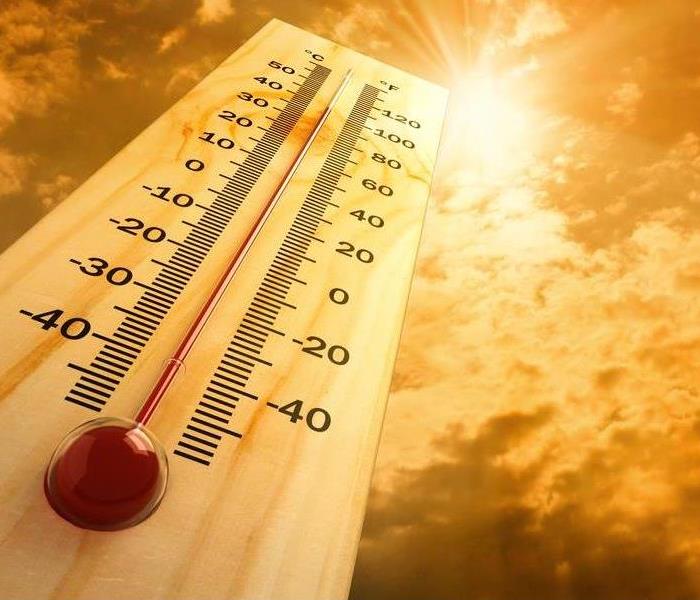 When it's hot and dry in Los Angeles, the risk of wildfire damage grows. Takes steps now to mitigate wildfire damage to your home or business.
When it's hot and dry in Los Angeles, the risk of wildfire damage grows. Takes steps now to mitigate wildfire damage to your home or business.
It's July in Los Angeles. It's hot and it's dry. In fact, July is the driest month of the year in sunny LA. Add it up, and summer is the season for increased risk of wildfire damage to your home or commercial property.
But there is a difference between "normal" summer temps and a genuine Southern California heatwave. First, after the sun sets, we'll get overnight lows in the high 60s or low 70s. This includes valley areas where it's hottest. Because of this, wise homeowners irrigate their lawns at night or in the morning, when it's coolest. But during a heatwave, overnight temps can linger in the 80s or higher! And the hotter it is, the faster that water evaporates, leaving foliage dry and parched.
As you no doubt know, dried out plants are a key fuel for wildfires. During our worst heatwaves, it's difficult to ensure lawns, trees and shrubs receive sufficient moisture, so they don't become kindling.
And when Los Angeles is experiencing a drought, or drought-like conditions, the state or county might place restrictions on water usage. Less water = increased wildfire risk.
Second, hotter temps make it harder to fight wildfires. They can feed a vicious cycle where the wildfire "creates" its own weather. Remember, hot air rises. As it does, the updraft can create the conditions for a "firestorm," increasing the frequency of strong wind gusts. And, of course, it's more difficult to contain a fire when high temperatures combine with strong winds.
Last, but not least, a heatwave can drive more people outdoors and to the refuge of the beach or mountains. Campfires, barbecues, fireworks and smoking (of cigarettes or the more herbal kind) can all spark a wildfire. Once a fire starts burning out of control, it can leave serious fire damage in its wake.
Preventing Wildfire Damage
The best way to fight a wildfire and prevent property damage is to stop one before it starts. If you're going to barbecue or chill out around the fire pit this summer, be sure they're fully extinguished when you're done.
There are also several things you can do to mitigate wildfire damage risks to your home or business. Proper management of your property, like cleaning debris from roofs and gutters or creating a defensible perimeter around buildings, is vital.
Most important, we need to support each other and our community during a wildfire emergency. Heed evacuation orders and help first responders by ensuring you and your family are out of harms way. Remember, nothing is more important than your safety. We can replace or restore your belongings. We can't replace or restore you.
Once firefighters contain the wildfire, and you're ready to begin the cleanup process, SERVPRO of North Hollywood is here to help. Our highly-trained and professional fire restoration service removes smoke and soot from a structure's interior and exterior. And we can also deodorize and improve the air quality inside the building.
We offer emergency restoration service to North Hollywood, of course, but also Universal City, Toluca Lake and areas of Los Angeles. We can clean up from any size water, fire or mold disaster. Call us 24/7, to make wildfire damage "Like it never even happened."
Stop Damage From Flash Flooding in Los Angeles
5/28/2021 (Permalink)
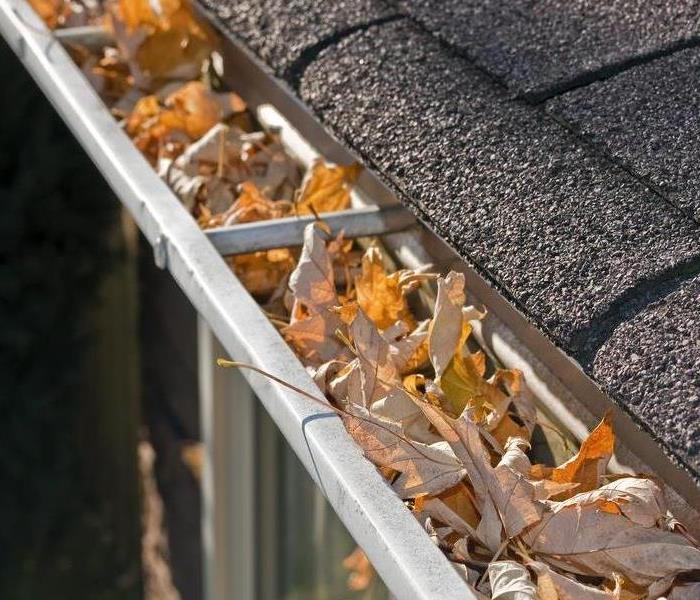 Do your gutters look like this? Clean them out to help prevent storm water runoff from flooding the ground floor rooms of your home.
Do your gutters look like this? Clean them out to help prevent storm water runoff from flooding the ground floor rooms of your home.
Rainstorms are rare in Los Angeles. Over a full year, we get about a month's worth of rainy days. Most of that rainfall comes between December and March. So with the summer months approaching, why write about rainstorms?
With the Palisades Fire still fresh on our minds, we're reminded that California's wildfires are a year-round concern. Between the large scale loss of vegetation and the near drought, dry conditions, heavy rain could bring the threat of flooding. And with floods so rare in sunny LA, homeowners might be uncertain how to handle one when it does happen.
Here are a few steps to take before and after a storm to prevent water damage to your property from a flash flooding event.
Before a Rainstorm
Before rain is in the weather forecast, there are a few things you can do around your home while it's still sunny and dry.
First, inspect and clean out your gutters. Experts recommend doing this at least twice annually to remove leaves, branches and other debris. It's a dirty and dangerous task, so you may want to hire a professional cleaning service instead of scaling a ladder yourself. Or consider installing gutter filters to keep larger debris from clogging them up.
Clean gutters help prevent water from pooling around your foundation and leaking into basements and crawl spaces.
Second, test your sump pump. "A sump pump is a pump used to remove water that has accumulated in a water-collecting sump basin." It is a valuable tool to stop your basement, crawl space or garage from becoming flooded by rain water. But only if it's working!
Plumbers recommend testing your sump pump every 3-4 months. It's easy to test a sump pump yourself. But you should call a licensed plumber to repair or replace your sump pump if you do find a problem.
Don't have a sump pump? Depending on the type, you should be able to have one installed for less than $2,000.00. That may seem expensive, but if it saves you from a flooded basement, you'll be happy you made the investment in your home.
After a Rainstorm
After the storm clouds part and the rain stops, be sure to check ground floor areas for signs of flooding. It's important to remove standing water in your basement or crawl space to prevent mold growth. Damp areas can dry without intervention, but fans and dehumidifiers may be needed to ensure a thorough dry out.
Circle the grounds and look for pools of water and soft spots around your foundation. Gutters and water spouts in good shape? Then you may want to make changes to your landscaping to soak up or help the water flow away from your home.
This is also a good time to look up for signs of water damage as well. Check for water spots on your ceiling, which is a sure sign of a leak in your roof. Inspect your roof for missing shingles, debris and other signs of disturbance and wear.
Flooding Disaster? Call SERVPRO of North Hollywood!
Flooding disasters happen, even to the most prepared property owner. If you discover a flood in your home or business, call SERVPRO of North Hollywood ASAP. We provide an emergency response to any size flooding disaster.
We've been serving North Hollywood and the surrounding Los Angeles community since 2007. As a local, family-owned company with national resources, we're here 24/7 to serve you and your family in your time of need. Call (818) 754-0050, and we'll make a flooding disaster "Like it never even happened."
Storm Damage? In Los Angeles? Take Steps Now to Prepare.
11/10/2020 (Permalink)
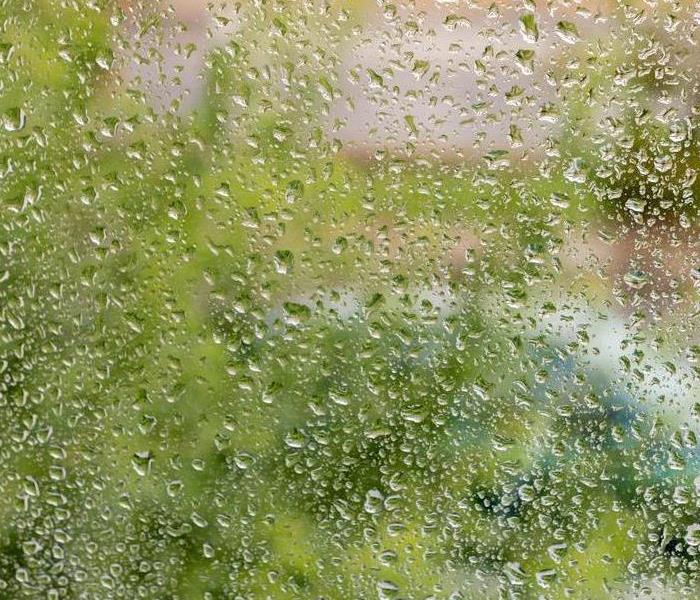 Can't wipe away the moisture on your windows? You might have a broken seal. Fix it before the rainy season arrives to prevent water damage and mold.
Can't wipe away the moisture on your windows? You might have a broken seal. Fix it before the rainy season arrives to prevent water damage and mold.
Anyone who lives in the Los Angeles area knows rain is an infrequent visitor to our region. But our rainy season is coming, with rainfall at its peak in December, January and February. If you get caught unprepared and find storm damage to your property, the restoration pros of SERVPRO of North Hollywood are here to help, day or night.
But it's better to prepare your property for the coming rainy season, in advance of its arrival. Here are a few tips to help you prevent storm damage before it happens.
Clean Storm Gutters & Roof
You have storm gutters on your home, in part, to divert rain water from your foundation. If full of leaves, sticks and other debris, clogged gutters and downspouts can actually cause a number of problems. First and foremost, rain water pools around your foundation, causing erosion. Water then seeps into those cracks and weak spots, flooding your basement or crawl space.
As you're cleaning out your storm gutters, take a look at your roof. If you find any leaves, dirt or debris, clear them away too. If you notice any damaged or missing shingles, fix or replace them.
When it rains, leaves and dirt become saturated with water, taking longer to dry. As with your foundation, storm water seeps through the roof, damaging shingles and the underlying rafters, joists and insulation. With enough rain, a dirty, weakened roof can lead to a water damaged ceiling.
You should also inspect your ceilings and look for signs of water damage. If you see brown water spots or peeling paint, you may already have a roof leak in need of repair.
In short, inspecting and clearing your gutters and roof can prevent more costly storm damage in the future!
Inspect Window & Door Seals
When was the last time you thought about your window and door seals? Last winter, as you wondered where that draft was coming from?
Otherwise, the caulk or weather stripping that plugs those tiny gaps between your windows and doors and their frames? Out of sight, out of mind.
But if drafts can slip through, so can moisture. While the water may be insufficient to cause a flood, mold needs little moisture to grow in those damp, dark places.
If you have multipaned windows, you should check the seal between panes. Look for moisture or fogginess on the window that you can't wipe off. Have windows with broken seals repaired or replaced by a pro, especially if under warranty.
Test Sump Pump
One of the best ways to prevent storm flooding, in your basement, crawl space or garage, is a sump pump. But the only way it can do that is if it's working. The worst time to find out your sump pump failed is in the middle of a rain storm.
Testing a sump pump is easy. All you need is about 10 minutes and a 5-gallon bucket of water. But if you don't have time or aren't sure what you're looking at, a certified, local plumber will help you.
Got Storm Damage? Call SERVPRO.
Even if you take the necessary precautions, the Los Angeles rainy season can come on surprisingly strong. Having hurricane socks and sandbags on hand, particularly if you live near wildfire burned areas, will help combat heavy rain storms.
If the worst happens and you find water damage or mold following a storm, call SERVPRO of North Hollywood at (818) 754-0050. Our certified and experienced storm damage restoration specialists are here, 24/7, to respond faster to any size disaster. We will assess the damage, extract, dry, clean and deodorize your property "Like it never even happened."
What is "Advanced" Water Damage Cleanup?
10/30/2020 (Permalink)
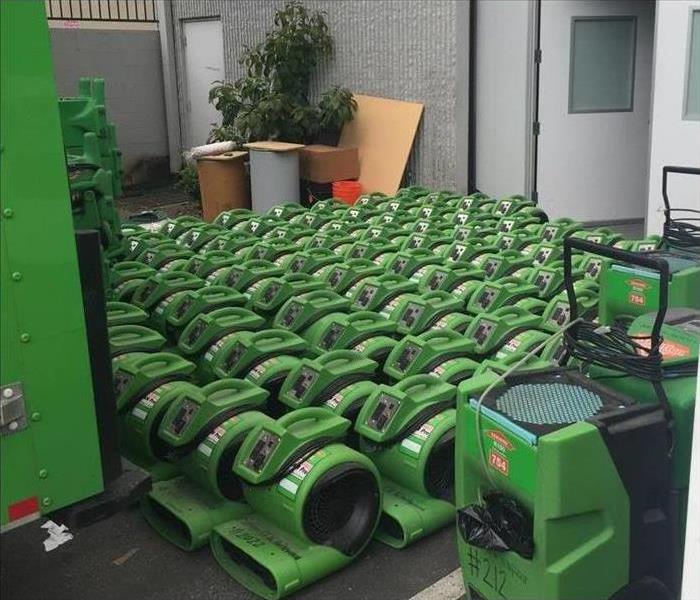 Our fleet of industrial strength air movers speeds up the process of water evaporation to keep hardwood & drywall from warping, swelling and staining.
Our fleet of industrial strength air movers speeds up the process of water evaporation to keep hardwood & drywall from warping, swelling and staining.
If your property suffers water damage, whether from a rain storm or a plumbing leak, you may be tempted to do the cleanup yourself. But effective water damage cleanup entails more than grabbing a mop and a bucket.
To ensure the most comprehensive recovery from a flood damage disaster, SERVPRO of North Hollywood uses “advanced water damage cleanup technology and techniques.” But what, exactly, does that mean?
Moisture Detection
First, sometimes you can't see all the damage. Water from flooding seeps into porous surfaces like walls or flooring. Left untreated, moisture can create perfect conditions for mold growth. Add oxygen, warmth and an organic surface like wood or drywall and voilà, you've got mold.
Hidden flood damage is no match for SERVPRO of North Hollywood. Our water damage cleanup specialists have sensitive moisture detection equipment like infrared cameras and hygrometers.
Infrared, or thermographic imaging, cameras reveal temperature differences behind walls, ceilings or floors. Areas damp or saturated with moisture read colder than nearby areas. A hygrometer measures humidity, or moisture, in the air. Combined, these devices reveal flooding damage not apparent to the naked eye.
Detecting, extracting and drying hidden water damage mitigates mold growth. These advanced restoration techniques make it less likely you'll need to call us for mold remediation services in the future!
Extraction & Drying
Finding the damage is just the first step. Removing the water and drying out the affected areas is critical to restoring your property to its preloss condition.
Sponges, towels or mops can help, of course. They can remove water on the surface. But to thoroughly clean up flood damaged property requires some more advanced technology and techniques.
Over time, moisture can warp, swell or stain wood and drywall and rust metal. Industrial strength air movers speed up evaporation, while dehumidifiers pull that excess moisture out of your ceiling, walls and floor.
During those rare Los Angeles rain storms, lack of drainage may cause flood water to build up in your basement or crawl space. Submersible pumps create powerful suction to extract gallons of standing water from those areas in seconds.
Deodorize & Disinfect
Some sources of water damage bring the risk of contaminants into your home or business. Cleaning up water from a backed up sewer, overflowing bathroom toilet or a rain storm also involves deodorizing and disinfecting the affected areas.
First, we use air scrubbers that remove contaminants from both the air and surfaces of your property. Just as humidifiers pull moisture from the air, air scrubbers pull microbes or other potentially harmful pathogens. At the same time, they release ionized oxidants to purify the air and extract odors.
We also use a variety of OSHA-approved and CDC-approved cleaning agents to disinfect surfaces and prevent bacteria, fungi or mold growth.
For Water Damage Cleanup, Call SERVPRO
A professional restoration service can handle all steps of the cleanup process. From detection and extraction to drying, cleaning, deodorizing and disinfecting, SERVPRO of North Hollywood is well-equipped to handle any size water damage emergency.
Los Angeles area homeowners, business owners or property management services can count on us for a fast response, 24/7. Call us at (818) 754-0050 to clean, repair and restore your property “Like it never even happened.”
What is California Doing to Prevent Wildfires This Summer?
6/3/2020 (Permalink)
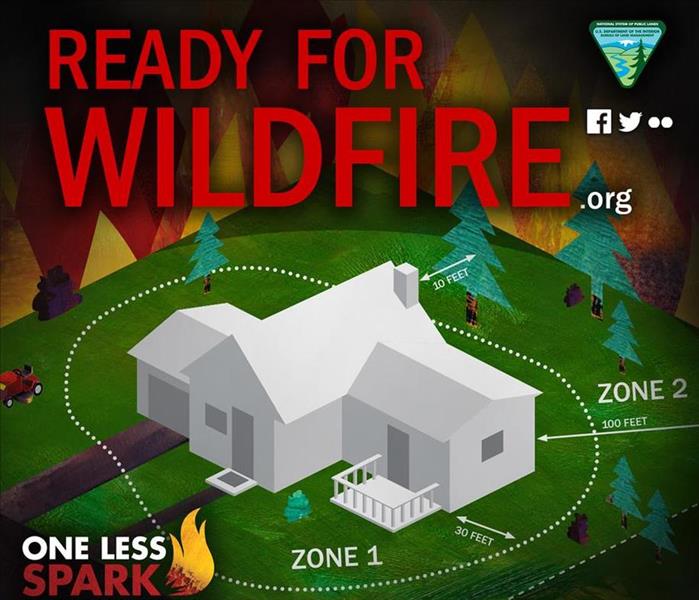 One thing you can do to prevent wildfire damage is establishing defense zones around your property.
One thing you can do to prevent wildfire damage is establishing defense zones around your property.
Every California summer brings with it the threat of wildfires. This summer is no different. Right now, there is a lot demanding our immediate, and understandable, attention. But we still should take steps to prevent fires from risking lives and damaging property this wildfire season.
What You Should Do to Prepare
First, we can do our part to prepare for wildfire season in Los Angeles. Create defensible perimeters around our properties by trimming overgrown trees and cleaning up dead leaves or debris. Review evacuation plans, test smoke detectors and fire extinguishers. Take precautions around BBQ grills and fire pits to keep them from sparking fires in the first place.
Businesses should also consider creating a SERVPRO Emergency READY Profile (ERP). Should a disaster occur, an ERP provides SERVPRO of North Hollywood with key information about your business. Our fire damage restoration specialists will respond quickly to mitigate and restore the damage, minimizing your costs and downtime.
Statewide Prevention Efforts
However, we can only do so much. With that in mind, Governor Gavin Newsom recently said that statewide efforts to prevent wildfires remain a priority.
“I want folks to know that we have been preparing for the upcoming wildfire season, and we’re not stepping back our efforts. We’re in fact stepping them up,” Newsom said at a press conference in May.
According to the Los Angeles Times, 2020 has already been a bad year for wildfires across California. Fires were up 60% through May, compared with the same months in 2019.
At the Cameron Park Fire Department, Newsom announced a 106-person wildfire safety commission as a division of the California Public Utilities Commission. In addition, his proposed state budget includes an additional $127 million for monitoring wildfires and other hazards.
The details on how utilities plan to mitigate wildfire risks this summer are available on the California Public Utilities Commission's website.
Wildfire Damage? Call SERVPRO!
Of course, it's unlikely we'll completely prevent wildfires this summer. Keep up with the latest info by visiting Cal Fire or following @CAL_FIRE and the L.A. County Fire Department on Twitter. And should your home or business suffer fire damage or smoke damage, SERVPRO of North Hollywood is ready to lend a hand.
Our highly-trained fire damage restoration team is here 24/7 to clean up, deodorize, repair and restore your property “like it never even happened.” Call us at (818) 754-0050. We're here to help!
Los Angeles Wildfire Season is Coming: Are You Prepared?
4/28/2020 (Permalink)
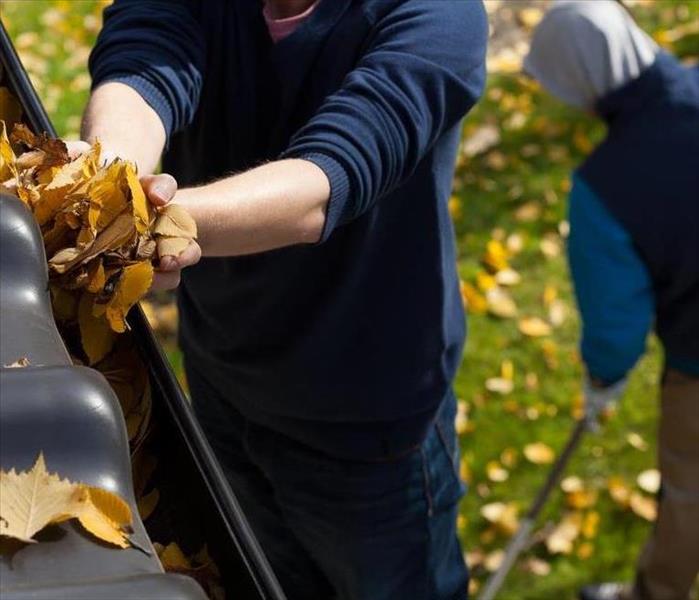 Clearing leaves and other debris from your roof and yard help to create a defensible space around your property in the event of a wildfire.
Clearing leaves and other debris from your roof and yard help to create a defensible space around your property in the event of a wildfire.
In the midst of the coronavirus pandemic, it is natural to focus on your most immediate concerns. That may be as simple as staying healthy or cleaning and disinfecting your property. It may be your job or the challenges of working from home.
If you have children, you may be focused on helping them keep up with school assignments. Or if you're a business owner, adapting your business to meet the changing demands of a world that's staying home is your primary concern.
In the near term, these are all vital things and deserve our undivided attention. But even in a pandemic, life continues, and now is a good time to prepare for other, inevitable things to come. For homeowners and property managers, that includes the summer heat and coming wildfire season.
Los Angeles Wildfire Risk
Because we live in such an urban area, we forget we are as susceptible to wildfires as the more remote spots in our state.
Our location in the San Fernando Valley is surrounded by woods. The Angeles National Forest is to the northeast. The Santa Monica Mountains are to the west. And the Hollywood Hills are to the south. Not to mention patches of parks and open spaces like La Tuna Canyon and Griffith Park. All provide ample fuel for wildfires during the hot and dry summer months.
In 2019, nearly 8,000 wildfires burned their way across California. October featured three large fires within Los Angeles County. The Saddleridge, Tick and Getty fires burned more than 15,000 acres and destroyed dozens of homes and property.
In other words, wildfires will happen. And they will impact cities like ours. The only question is when.
Preventing and Mitigating Fires
Some Los Angeles wildfires start from things that are our our of our control, like faulty power lines. But there are things we, as property owners, can do to help prevent fires in general.
The first and most obvious is preventing kitchen fires. Cooking is the leading cause of home fires, so pay a little extra attention while preparing dinner.
Likewise, it's a good idea to take precautions while using your BBQ or gathered around a fire pit. And be sure to test your smoke alarms and have fire extinguishers charged and at the ready!
Preparing for Wildfires
Beyond taking care around your own fires, there are other things you can do to prepare your property in the event of a wildfire.
For homeowners, you can prepare for wildfires by creating a defensible perimeter around your home. Clear leaves, branches and other debris from your roof and yard, and trim plant growth around your property. You should review evacuation plans with your family, or create one if you haven't already.
For business owners or commercial property managers, you can prepare for wildfire season a couple ways. First, take extra care in managing flammable materials. And go over your business continuity plan. The last thing you want is to compound the current challenges with additional lost revenue due to fire, smoke and soot damage.
SERVPRO is Here to Help
If nothing else, the coronavirus pandemic proved the difficulty of preparing for every possible disaster. But we are spending a lot of extra time at home. Using some of that time to prepare for the annual Los Angeles wildfire season may help you avoid another headache this summer.
Should your property suffer fire damage, whether from a wildfire or another source, SERVPRO of North Hollywood is here to help. We're available 24/7 to clean, deodorize, repair and restore your home or business "Like it never even happened."
Why Los Angeles Homeowners Need Flood Insurance
11/8/2019 (Permalink)
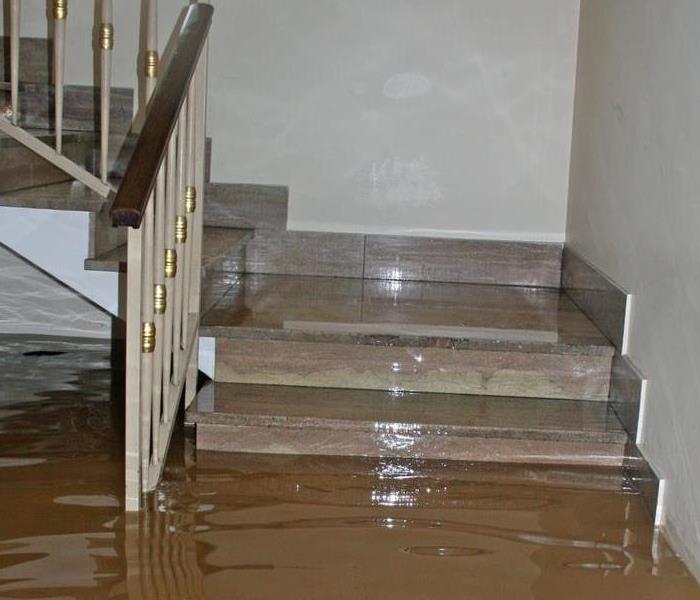 Just one inch of water can cause over $10,000 of damage to your home. Having flood insurance is vital to protect against a serious flood damage loss.
Just one inch of water can cause over $10,000 of damage to your home. Having flood insurance is vital to protect against a serious flood damage loss.
Following a dry and hot summer, most Los Angeles homeowners have one eye on the handful of wildfires burning nearby, and the other on Red Flag Warnings that portend increased wildfire risk.
But believe it or not, now is also a good time to get ready for wet weather, because, when rain storms do arrive following wildfires, they'll carry an increased risk for flooding and mudslides.
Every rainy season, yes, even in Los Angeles, brings the threat of flood damage to your home or business along with it. But following our spate of wildfires, the risk of flooding grows greater as the fires burn away vegetation that would normally soak up the rain.
Of course, most homeowners, and some renters, do carry insurance to protect themselves against property losses. However, flooding is one natural disaster that is not typically covered in an insurance policy.
This is in spite of the fact that flooding is, historically, the most common natural disaster in the world, surpassed only recently by wildfires across the U.S. And in California, the frequency of both wildfires and floods is only expected to increase.
Enter the National Flood Insurance Program (NFIP). Established in 1968, the FEMA administered program "aims to reduce the impact of flooding on private and public structures. It does so by providing affordable insurance to property owners, renters and businesses and by encouraging communities to adopt and enforce floodplain management regulations."
You can purchasing an NFIP policy through an affiliated insurance agent, though they are only available if you live within a participating community (which appears to include most, if not all, cities in Los Angeles County).
Keep in mind that most flood disaster policies only cover flooding damage from a natural event. If the flooding was caused by a sewer back up or an overflowing toilet, it may not be covered by this particular type of policy.
There are also private flood insurance options, which can be less expensive and may provide higher levels of coverage. However, as private flooding insurance plans were rare prior to 2014, they are also somewhat untested in their response to a flooding disaster.
While Los Angeles and the surrounding area is not considered a high-risk flood zone, FEMA notes that "more than 20 percent of flood claims come from properties outside high-risk flood zones." Further, repairing flood damaged property is quite expensive. A single inch of water can cause upwards of $10,000 worth of damage.
Fortunately, SERVPRO of North Hollywood is here to help! Our certified restoration specialists respond faster, 24/7, to any size flooding disaster with the training and technology necessary to quickly mitigate a flood damage emergency. We not only dry, clean and deodorize your water damaged property, we also rebuild and restore damaged areas to make a flooding disaster "Like it never even happened." And we also work directly with your insurance company, reducing stressful bottlenecks and bringing you much needed peace of mind.
What is a Red Flag Warning?
10/28/2019 (Permalink)
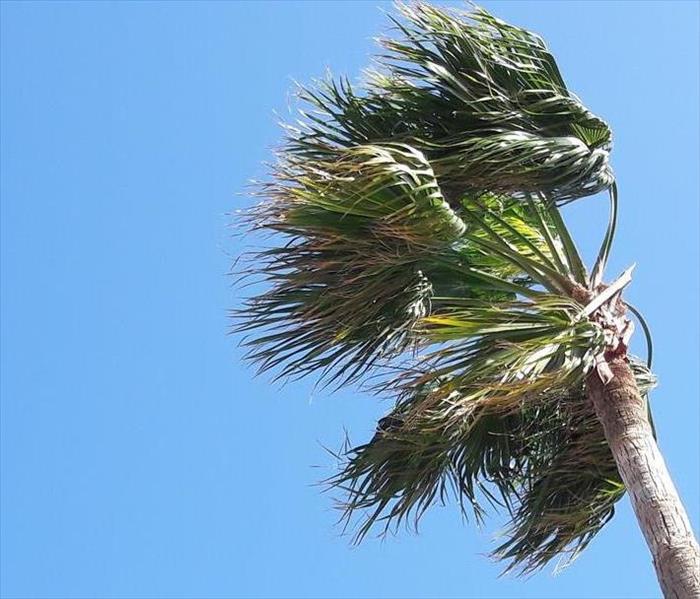 Sustained high winds, coupled with dry heat, increase the risk for wildfires in LA. Help prevent fire damage to your property with these tips.
Sustained high winds, coupled with dry heat, increase the risk for wildfires in LA. Help prevent fire damage to your property with these tips.
As wildfires burn across California, several areas, including Los Angeles County, have also been given a Red Flag Warning. But what does that really mean for LA residents and property owners? And are there things you can do to help prevent fires from spreading in your area?
What Does a Red Flag Warning Mean?
A Red Flag Warning means take action. They are issued by the National Weather Service when the potential for fires in a given area is at its peak. Typically, that means sustained winds, high temperatures and low humidity.
Dry heat is, of course, a pretty typical Los Angeles day, which is why the threat of wildfires has become a constant. The winds are the primary variable, and when the Santa Ana winds are blowing (as they are now, thanks in part to El Niño), small sparks can easily ignite into a blaze.
What is a Fire Weather Watch?
A Fire Weather Watch means that there is the potential for wildfire conditions, but that weather is not considered "imminent or occurring." Property owners should still be prepared and vigilant.
How to Prevent Fires During Red Flag Warnings & Watches
When your area is under a Red Flag Warning or Fire Weather Watch, it is vital to prepare your property for wildfires.
Important steps include:
Having an evacuation plan
Cleaning gutters, roofs and yards of debris such as dry leaves, twigs and branches
Moving flammable liquids like gas cans and tanks of propane away from your home
Checking that garden hoses, pressure washers and fire extinguishers are functional and accessible
Be extremely vigilant with heat and open flames from BBQs, fire pits and cigarettes and never leave a fire unattended.
If wildfires are burning in your general vicinity, keep windows and doors closed and, if possible, reduce the use of HVAC systems like central A/C and heat to prevent smoke and soot from entering your home.
Ultimately, the most important thing is the safety of you and your family. Head mandatory evacuation orders and stay up to date on the latest conditions by subscribing to alerts or following the Los Angeles Fire Department on Twitter, Facebook or Instagram.
Once the flames are out, call SERVPRO of North Hollywood anytime, 24/7, to assist with fire damage cleanup and restoration. We're here to help!
P.S. Don't forget! After a wildfire the risk of storm damage increases. Be prepared for a disaster by creating a SERVPRO Emergency READY Profile today.
Los Angeles Summer Safety Tips
7/23/2019 (Permalink)
 Summer days in LA can be fun for the whole family. But don't forget to apply the sunscreen before you hit the beach!
Summer days in LA can be fun for the whole family. But don't forget to apply the sunscreen before you hit the beach!
When you think of summer in Los Angeles, you probably think of palm trees, beach days and lots of bright sunshine. And why not? One of the top reasons people choose to live in Southern California is the great weather.
But that doesn't mean it's all sunshine and roses living here in LA. Indeed, these National Weather Service safety tips will help you deal with the hazardous conditions that can interrupt those lazy, hazy days of a Los Angeles summer.
Poor Air Quality
Warm weather naturally draws people outdoors. But whether you're lounging by the pool or hitting the trailhead for a long hike, check the National Weather Service's Air Quality Index (AQI) before you go out.
The AQI forecasts the concentration of ozone and particulate matter in the atmosphere. Even at lower concentrations, exposure to air pollution can create lung irritation and lead to wheezing, coughing and asthma attacks.
A number of factors can degrade air quality, from emissions from vehicles, factories and power plants to natural disasters like wildfires. On days when the air quality is considered unhealthy, you should limit or even avoid strenuous activities such as bike riding, running and hiking. Indeed, on the worst days, just stay inside and enjoy your ac.
Beach Hazards
A day at the beach offers plenty of fun in the sun but is not without its risks. Even on a sunny, cloudless day, stay vigilant for rip currents, which can be a hazard for even the most experienced swimmers and surfers.
Meanwhile the same heat waves that drive us out to the beach can also drive us back inside thanks to lightning and thunderstorms that cause beach evacuations. So keep one eye on the forecast before heading to the beach and another on the skies while you're there.
Lastly, heat and sun exposure can cause heat related illnesses like sunburns and heat stroke. Protect yourself by staying hydrated, using sunscreen and taking refuge in the shade or indoors if you feel faint or disoriented in the sun.
Drought Conditions
Officially, California is 100% drought-free for the first time in nearly a decade. But we know that's likely a temporary reprieve and Los Angeles area residents should be aware of the damage that can be caused by prolonged dry spells and prepare now for drought conditions.
The most devastating hazard during dry weather, as most Californians know, is wildfires. Be sure to review the ways you can prepare your home and mitigate the risk of fire damage from a wildfire.
That said, when the rainstorms do come, dry weather can also increase the risk for flooding, especially when the storm follows a wildfire. Likewise, there are several things you can and should do to prepare your home for rainstorms while it's dry.
And remember, SERVPRO of North Hollywood is here 24/7/365 to assist you following a storm damage or fire damage disaster. Our highly-trained team of restoration specialists can help you recover important and cherished belongings and return you to those carefree summer days quickly and efficiently.
Preparing for Storms During El Niño
6/14/2019 (Permalink)
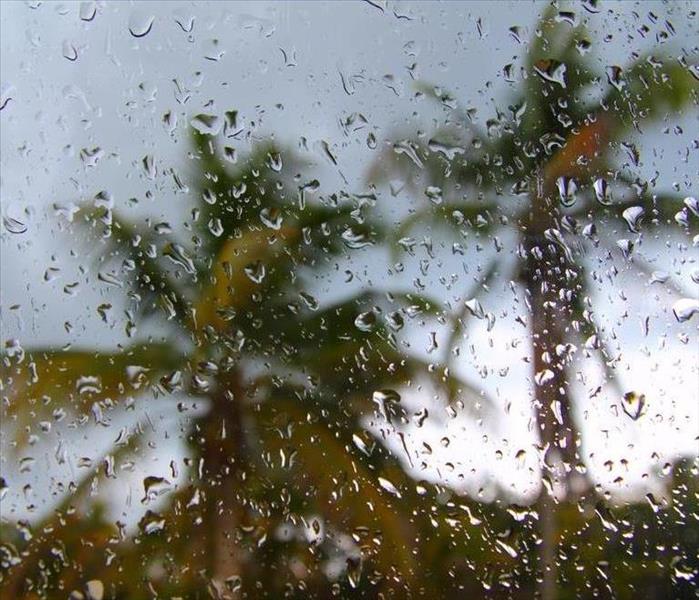 Rainstorms in LA may increase in intensity during El Niño. The best way to mitigate storm damage is to prepare for rain while it's dry.
Rainstorms in LA may increase in intensity during El Niño. The best way to mitigate storm damage is to prepare for rain while it's dry.
Do you know the difference between El Niño and La Niña? Roughly translated, El Niño means "The Little Boy" or "Christ Child" while La Niña means "The Little Girl."
More importantly, whether the Pacific Ocean's conditions are in the El Niño, La Niña or a neutral phase can impact the frequency and intensity of storms, and the risk of storm damage in Los Angeles and across Southern California.
How Does El Niño Affect LA Weather?
During an El Niño phase, weaker surface winds lead to a rise in the Pacific Ocean's surface temperature. The warmer the temperature of the ocean, the more the atmosphere above it moves.
The effect is an increase in instability and a higher risk for more intense storms and rains, particularly over the southern part of the United States, including Los Angeles and So Cal in general.
The shift to a weak El Niño phase happened earlier this year and likely contributed to our wet winter and spring. That rainfall may have increased the risk for summer wildfires, although that's a separate issue altogether.
But El Niño conditions also typically last 9 to 12 months, so the potential remains for intense rainstorms throughout this summer and into next fall and winter.
Preparing for El Niño Storms
Because rainstorms an infrequent concern to property owners in Los Angeles and the surrounding area, many people don't think about preparing for a storm until it arrives, and by then it may be too late.
Should rainstorms cause flooding or water damage to your home or business, be sure to call SERVPRO of North Hollywood right away. We can begin assisting you in your clean up and recovery efforts immediately.
In the meantime, the best time to prepare your home or business for rainstorms is when it is dry. Here are five simple steps you can take right now to mitigate the potential for water damage from intense storms:
Check for and repair leaks in your roof, around windows and doors and in your basement or crawl space
Clean out your gutters and downspouts to maximize the flow of water away from your building
Install a sump pump, or if you already have one, get it tested by a local plumber
If you live near areas affected by wildfires, prepare for potential mudslides by having sandbags on hand, restocking first aid kits and, if necessary, creating or reviewing your evacuation plan
Consider investing in a generator; this is particularly important for businesses to minimize downtime should you lose power during a storm
Last, but not least, add (818) 754-0050 to your speed dial. And should disaster strike, call SERVPRO of North Hollywood. We're here 24/7 with the fastest response to any size storm disaster.
After the Wildfire: Storm Damage Dangers
6/14/2019 (Permalink)
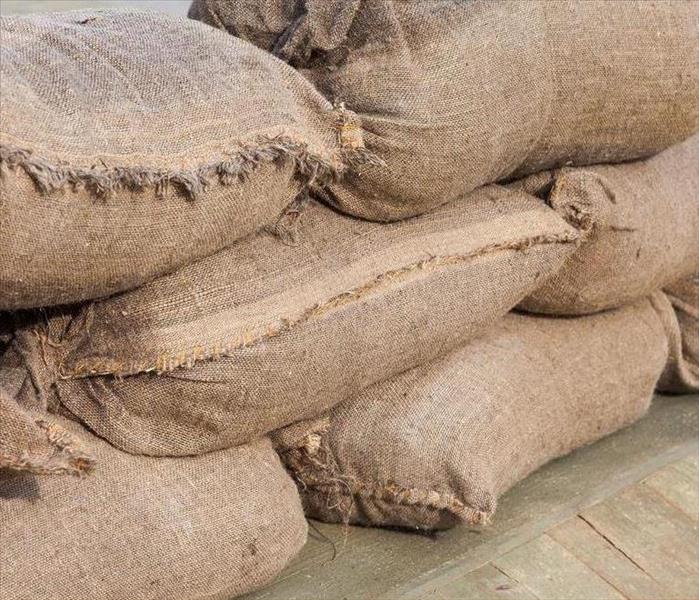 When used properly, sandbags can be an effective defense against storm damage from flooding and land or mudslides.
When used properly, sandbags can be an effective defense against storm damage from flooding and land or mudslides.
Wildfires have become a year round concern for property owners in Los Angeles and across Southern California. But there are a few things homeowners can do to prepare your home for wildfires. Likewise, business owners and property managers can take steps to mitigate the risk of wildfire damage to your commercial property.
But even once the fire is out and the smoke and soot is cleaned up, property owners should remain vigilant. Indeed, the greatest risk for storm damage often occurs in areas ravaged by fire. The storm damage dangers usually come in two forms: mudslides and floods.
Mudslides
Even if it's been several years since wildfires last burned the slopes near your home, the potential risk for mudslides can remain. It doesn't require much time or precipitation to start a "debris flow." An intense rainstorm can start moving rock, earth and other debris within minutes. Mudslides move very fast, leaving little time for a homeowner to react and respond.
If you live in the hills, the most important thing you can do to prepare for the kind of storms that could start a mudslide is to have an emergency kit and an evacuation plan. Sign up for emergency alerts from Los Angeles County and always heed the orders of first responders if required to evacuate.
There are also improvements you can make around your property to protect your home from mudslides, such as planting trees and shrubs or building channels and barriers to deflect runoff. Always follow the recommendations of a qualified geotechnical engineer to maximize the efficacy without putting neighboring properties at risk.
Lastly, review your home insurance policy. The National Flood Insurance Program may cover damage from debris flow as well as flooding. And SERVPRO of North Hollywood works directly with all major insurance carriers, reducing your stress should your property experience storm or water damage covered by your policy.
Floods
Meanwhile lower lying areas, such as the foothills of the Verdugo Mountains and the San Fernando and San Gabriel valleys, also share storm damage risk following wildfires in the form of flooding.
The decreased vegetation in burned out areas means that less of the rainwater gets soaked up by thirsty trees and shrubs. With little to nothing to absorb it, the rainwater naturally flows downhill and, during intense storms, can rush with surprising speed and force.
Like property owners in the hills, the best way to prepare for storm floods is to have emergency supplies and an evacuation plan. Meanwhile there are plenty of things you can do around your home to mitigate flood damage risk, including cleaning out gutters, inspecting for leaks and installing a sump pump in your basement or crawl space.
If you live in a flood risk area, talk to an insurance agent about The National Flood Insurance Program. You may even qualify for reduced premiums based on your location, income and any flood mitigation steps taken to protect your home or business location.
Should the worst happen and your property suffers water damage from a storm, be sure to call SERVPRO of North Hollywood right away. We're here 24/7 to respond immediately to any size disaster and clean up and restore your property "Like it never even happened."
Storm Damage Inspection Checklist
9/29/2018 (Permalink)
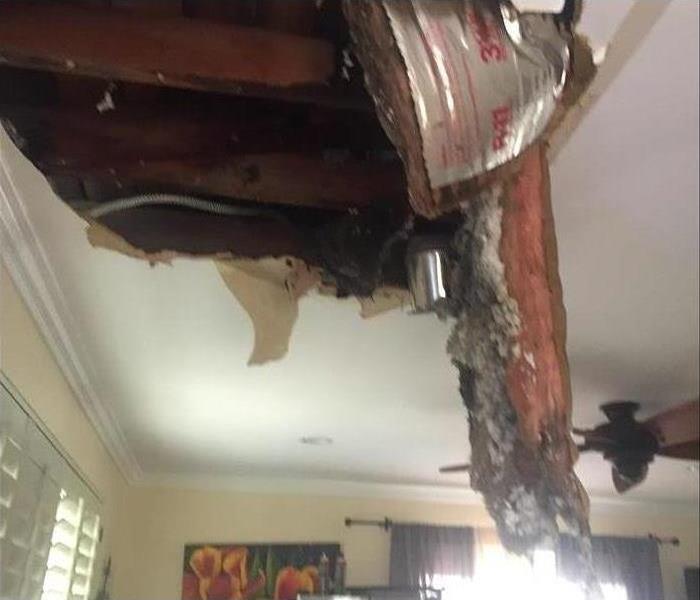 SERVPRO of North Hollywood can clean up and repair even the worst water damage and restore the drywall to make it look like new again.
SERVPRO of North Hollywood can clean up and repair even the worst water damage and restore the drywall to make it look like new again.
Storms may be an infrequent threat to Los Angeles area homes and businesses, but it never hurts to prepare for the rainy season even while it's dry.
When the heavy rains and winds do come, be sure to review this storm inspection checklist to discover any water damaged areas before they become an even bigger problem.
Roof
High winds, rain and falling tree branches can dislodge shingles, gutters and other protective elements. Visually inspect your roof and look for anything that's loose or missing, as well as any remaining debris. If you have access to the attic, be sure to also check for leaks or other signs of water damage.
Foundation and Crawl Space
Heavy rains can cause water to pool near the base of your building and increase the pressure on your foundation. Look for cracks where water might seep into the foundation and escape into your crawl space or basement. Be sure to also inspect and keep gutters clean and in good working order to limit water soaking into the soil around the building, which can cause rapid foundation settling.
Outlets and Electrical Fixtures
Most people know that water and electricity are a bad combination. Water can cause an electrical outlet to spark and start a fire. And because water conducts electricity, there is risk of electric shock if your skin comes in contact with damp areas around electrical units.
Water damage can also cause electrical wires to become corroded over time, so proper drying and replacement of damaged wires is vital. If you discover moisture anywhere near an outlet or electrical fixture, cut the power to the area and call SERVPRO of North Hollywood ASAP.
Carpets and Flooring
If it goes unnoticed, storm water can seep into floorboards, discolor baseboards and rot and weaken the wood. Moisture can also collect between carpeting and floorboards, causing mold growth. So it's important to look for standing water or damp spots have them dried quickly and properly.
Walls and Ceiling
As with your floors, water leaking through your roof or between windows and trim can discolor ceilings and walls. Or worse, they can become weakened until the wear becomes holes in the drywall and plaster.
Unseen leaks can also cause mold to grow on or behind your walls. You should inspect for visible discoloration or damage, but if you suspect there may be leaks you cannot see, there are leak detection specialists who can help find problems before they cause major damage.
As with any damage to your property, the safety of you and your family should be your first priority. Beyond that, if you find signs of storm damage around your home or business, call SERVPRO of North Hollywood. Our highly trained and experienced technicians are available 24/7/365 to clean up, repair and restore your property faster than you can say "but it never rains in Los Angeles."
Summer Storm Damage Risks
7/15/2018 (Permalink)
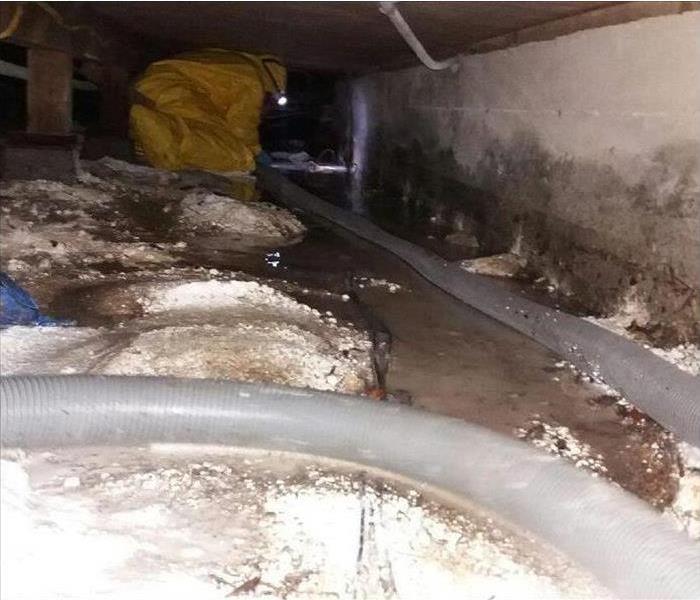 Storm floods can leave inches of water under your home. Stagnant water can collect bacteria, mosquito eggs and cause excess humidity
Storm floods can leave inches of water under your home. Stagnant water can collect bacteria, mosquito eggs and cause excess humidity
Summertime in Los Angeles brings beach days, barbecues and, usually, sunny, cloudless blue skies. Occasionally those skies darken with storm clouds and homeowners are at risk of property damage caused by a number of naturally occurring events. When the weatherman warns of impending summer storms, here are a few things So Cal homeowners should watch out for:
Rain
Summer rains often come down fast and hard, especially in the Valleys, leaving LA area properties at risk of flash floods. When your street seems more suited for transport by boat than automobile, keep a close eye on lower lying areas, especially if your house finds itself in the path of runoff from surrounding hills. Basement and crawlspace flooding is a common problem, but other disasters such a sewer backups or leaks from damaged roofs, windows and doors can create inhospitable conditions in your home.
Wind
Water damage isn't the only concern for homeowners during summer storms. High velocity wind gusts can join the rain and bring down power lines, sparking fires. Powerful storm winds can also tear shingles off roofs, rip large branches off trees and rattle old windows and doors. While you can prepare for potential water damage from storms even when it's dry, it's harder to prepare for when Mother Nature decides to cave in your roof. Fortunately, SERVPRO of North Hollywood has experience with such disasters and we can help make your home look as good as new.
Lightning
While seemingly more rare than heavy rain and wind, summer storms also bring lightning and thunder. Indeed, in August, 2017 lightning struck 2,100 times across Southern California in just one week. So while the rumble of thunder might cause you to hide beneath your covers, it's the ensuing lightning strike that can cause bigger problems for homeowners. In particular, lightning strikes can spark fires, especially in the dry and heavily wooded areas of the hills and mountains in Los Angeles, creating wildfires that can rapidly spread and threaten residential and commercial property. While rare, lightning can also strike a home directly, such as one earlier this year in Whittier.
Hail
A rare occurrence, particularly in LA, hail can bring its own unique concerns for homeowners. Small hail in Los Angeles causes buzz on social media, but larger hail can actually put holes in your roof and break windows.
So should rain, wind, lightning or even hail damage your North Hollywood, Universal City, Toluca Lake or Los Angeles property, be sure to call SERVPRO of North Hollywood for a fast response, 24/7 and our highly trained restoration technicians will be on the scene to restore your residential or commercial property "like it never even happened."
3 Ways to Prepare for the Rainy Season (While It's Dry)
6/8/2018 (Permalink)
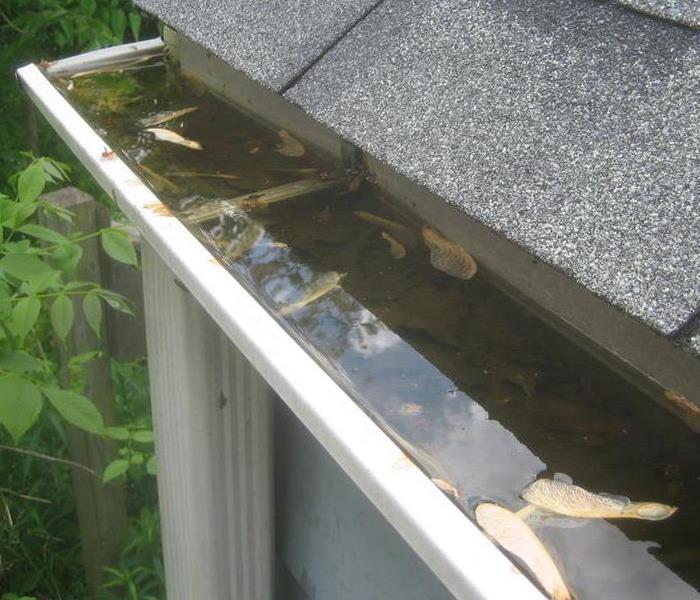 Clogged gutters can lead to water damage.
Clogged gutters can lead to water damage.
Summer is here and while your mind may be on pool parties, day trips to Malibu and, of course, BBQ, SoCal's rainy season will be here before you can say "trick or treat!" While the memory of last year's wildfires may prompt you to take steps to protect your property from fire damage, now is also a good time to prepare for the coming storms even while it's dry.
Set up a rainwater collection system
Rainwater harvesting offers many benefits, including reducing your water bill and providing an alternative water source during droughts. The capturing, holding and controlled releasing of rainwater can also help reduce runoff, particularly in heavily paved urban areas which, in turn, can reduce the risk of flooding around both residential and commercial buildings.
Clean gutters
Gutters and downspouts catch storm water and direct it away from your home. When properly cleaned, gutters help prevent the soil surrounding the building from becoming so heavy and saturated with water that it stresses your foundation. Over time, enough wear causes foundation walls to crack which can lead to a flooded basement (and, perhaps, a call to SERVPRO of North Hollywood).
Inspect for signs of leaks
Water marks, peeling paint or wallpaper, damp walls or floors and, in some cases, mold or mildew are all signs of leaks that should be fixed before they can cause major damage. Don't forget to also inspect your roof and look for loose or missing shingles which are prime places for rainwater to leak into your home.
Of course, if the worst should happen and you find yourself dealing with water damage in your home or business, call us right away. Our highly-trained water restoration technicians are "faster to any size disaster" and have experience, expertise and equipment to restore your property properly.
Storm Damage Disasters in Hollywood
5/31/2018 (Permalink)
Water damage is one of the serious issues people in California face and regardless if it is caused by a leak in the pipes or flood damage, it should be mitigated immediately to avoid financial drainage. The damage in homes and businesses being common, people should have the best company in North Hollywood, CA contacts to call when they have water in home or water in the business situation.
In cases of flood damage, there is not much one can do. However, it does not necessarily mean they sit and watch. Some mitigation can be done to this problem. In any case, the power should be switched off to avoid electrical issues.
First, the resident should move all their properties to a place where they are safe from the water, then make the call to a Water Restoration Company in North Hollywood. A company like SERVPRO works twenty-four hours in a day so there is no worry of not being able to reach them.
For leaking pipes, water in a home, the owner should close the main water supply this will ensure no more leaking is experienced; in water in business in case of rental premises, the owner can be contacted to shut the supply. Then, call the water restoration company to help out in drying.
Air movement is important, and windows should be opened; use of heaters and fans can also ensure sufficient air movement; without that, it can be risky to humans. An air inspector should be called to check the quality of air and reassure that air movement is good; they do have the equipment to check drying of walls. Complete drying will reduce the growth of mold this reduces dangers that can be caused by them.
There are specialists in California that come to check the extent of the damage caused by water, and how efficient the water cleanup and water restoration was. The inspector can recommend the next action to be taken after he does the inspection. Commercial buildings might have been significantly affected, and it might have become weak and demolition might be the answer; building from scratch can be the only way to be sure the occupants will be safe.
Dealing with insurance after such an event can be hectic, but at least the owners will not feel so much financial restraint. Most building in Hollywood, CA, has been insured against water damage and as much as it is not easy to do the claims, in the end, it will be easier. After the water cleanup filing claim is the next step; insurance company will not accept to pay for negligence, so mitigation is an important step. An advance from the insurer for moving as the repair is done will come in handy, but the owner should keep in mind it will be deducted from the overall payment.
Water damage in Hollywood can be a depressing situation, but the people of CA have taken measures to ensure that as much as they cannot avoid, they can reduce the stress after the outcome. Visit http://www.SERVPROnorthhollywood.com for more information on water damage.
3 Steps To Take After Sewer Backup Floods Your Home
4/11/2018 (Permalink)
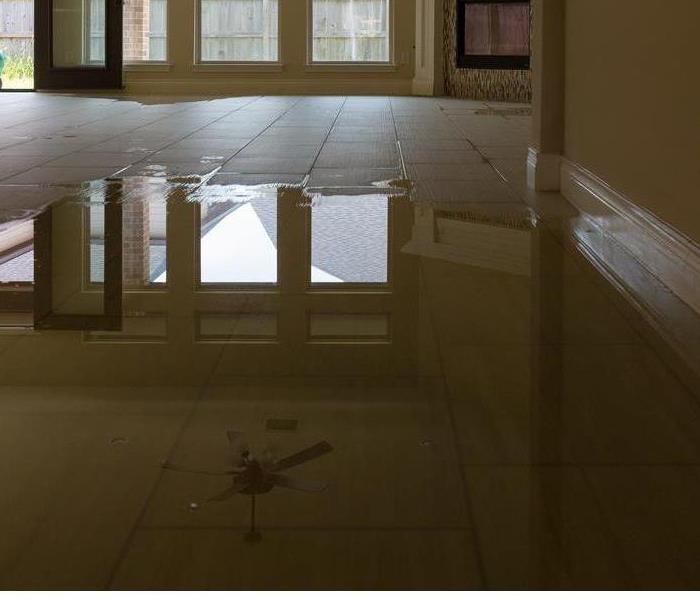
Flooding in Hollywood, CA can cause downed trees, severed power lines and water damage throughout your neighborhood. However, one of the most distressing results of flooding is when sewage systems fail and cause a sewer backup in your home. The resulting mess can be difficult to handle when it first happens, but acting quickly and taking a few simple steps can help keep your home and family safe.
1. Evacuate Your Home
Flooding that contains sewage is known as black water and is usually harmful to people and animals. The water may contain chemicals, human waste and other pathogens that can cause serious illnesses. If a sewer backup occurs in your home, get everyone away from the flood waters and have them move to a safe area, such as a neighbor’s home. Do not allow anyone to enter flooded rooms to retrieve items.
2. Seal Off Main Entrances
Floods caused by rain water can travel quickly, even when it enters your home. Once you get your family to safety, seal your home’s entrances with thick, wide tape and plug any gaps with heavy cloth to prevent any water from leaking out. Be sure to wear gloves and a protective mask as you do this and make every effort to avoid touching the contaminated water.
3. Call a Storm Damage and Cleanup Company
Sewage floods are best handled by a storm damage and cleanup company, as their technicians have the training and equipment to handle the removal of dirty sewer water safely. Trash pumps and other machines will likely be employed to handle the worst of the mess, and flood techs can advise you about what other services you might require. These may include the tear out of damaged carpeting and drywall, as well as cleaning and deodorizing options.
When flooding in Hollywood, CA causes a sewer backup in your home, the results can be devastating. Knowing how to react calmly and knowing which steps to take can minimize damage and keep your family safe. Visit http://www.SERVPROnorthhollywood.com for more information on storm damage.
Tools for Removing Basement Water
1/18/2018 (Permalink)
Basements can flood for all sorts of reasons. No matter why you have found two feet of water in your basement, you need the right equipment to remove it. Here are a few things you might need:
• Sump pump
• Trash pump
• Truck mounts
• Safety equipment
Depending on the actual problem, you may need require equipment too. Furthermore, what you use may depend on what is available in North Hollywood, CA, at the time.
Trash Pump
This term is another name for a sewage pump. In many cases, this is the best tool for removing standing water from a basement. Some of these pumps are electric, which means you have to plug them in. This can cause obvious hazards and can also be an inconvenience.
If you go this route, choose a unit with a gas engine. It can run without being near a working electrical outlet. This setup is much safer.
Sump Pump
Check and see if your home has a sump pit. It so, you may be able to use to the corresponding pump to remove the water. You may need to dig a ditch to make this work. Do this at the lowest point of the slope for best results. Unfortunately, many homeowners can do more harm than good while trying to do this themselves.
Professional Assistance
Does all of this sound confusing or overly complicated to you? Sometimes, it takes a professional team to clean up the mess that a flooded basement leaves behind. You can call a restoration company in North Hollywood, CA, to take care of the problem for you.
Better yet, these companies have the equipment and experience to look for other problems. Not only will they bring their sump pump, trash pump, and other tools, but they can also look out for issues that might occur down the road. You can avoid mold and other problems by asking for help.
Visit SERVPRO of North Hollywood at http://www.SERVPROnorthhollywood.com/ for more information about storm restoration.
My House Has Storm Damage – What Should I Do?
9/28/2017 (Permalink)
My House Has Storm Damage – What Should I Do?
To an average human being, a home is a place for comfort. It is a safe zone from all the earthly troubles. People find peace and tranquility in their abodes. But if, the home is destroyed, the question is what would anyone do?
Storms are notorious for destruction of houses. Floods, winds, hurricane or even a hail storm can bring destruction to your doorsteps. A storm is first nail in the coffin in the destruction of one’s house. There could be anything – flood damage, wind damage, storm damage, hurricane damage, hail damage, ice damage, even river flooding– usually causing roof damage, roof leak, frozen pipes, ice damming (ice dam), ground water, and cracked walls and windows.
In short, it will first destroy one’s home, then render all of their stuff useless in the form of flooding, heavy rain. Chances are if one doesn’t do anything quick about it, one would have to bear the loss of a home as well as the loss of every usable material which perished alongside the house.
Even if hail damage, hurricane damage, ice damage or flood water is not that severe, roof leaks are common. That makes impervious for the house owner to spend money on roof repair.
So, What Should One Do?
If there is wind damage, hail damage, hurricane damage, ice damage or any kind of storm damage including river flooding, ice dam, ice damming, or frozen pipes, ice damming, roof damage or roof leak, there is need of home restoration. After all, the roof damage, roof leak, ground water, and ice dam should be repaired. What one can do for roof repair and overall home restoration, again?
One should call a team of professionals. They have years of experience in storm remediation, home restoration, and water restoration. Below, there is a list with all the reasons which make a strong argument in the call of professionals, and not DIY methods for home restoration.
Offer Valuable Advice
There are different types of storms. Flooding storms, hail storms, tornado storms and so forth. While each of these storms common in terms of catastrophe, they are different in terms of insurance categories. Whenever such catastrophe falls on anyone, it is natural to feel down and not give 100% in anything. When this happens, one can’t think clearly. Who knows… there might be some insurance, but due to sudden news of danger, this valuable information may slip off a person’s mind.
A professional service could offer optimum advice in these cases like river flooding, storm damage, wind damage, – One can confidentially discuss all the insurance plans and how they can help in storm restoration (like roof repair, ice damming removal, and frozen pipes repair). Sometimes, it is even difficult to file a storm damage claim with the house owner’s insurance company. It is a good strategy to speak to a lawyer who has significant experience in this field, but then again, it is a hassle to find a good lawyer whose expertise lies in cases like hail damage, hurricane damage, frozen pipes, roof damage (roof leak, ice dam), wind damage, storm damage, ice damage, ground water, or river flooding/flood water.
Most of these professional companies have joint ventures with lawyering firms. These guys can connect a storm victim to some of the best lawyers in town for optimum storm restoration or storm remediation of his/her house. The process of filing a storm damage claim is long and tedious. So, the sooner one speaks to their insurance claim attorney, the better the chances of things moving forward. Again, in respect to giving advice, the professionals can prepare a people better for their interview with the insurance guys. They will provide their valuable counseling which will considerably increase their chances of having a decision turn into their favor.
Experts in Scavenging
Alright. The home might be destroyed due to flooding or a devastating hurricane (storm damaged)? But, that definitely does not mean that all that is destroyed cannot be used. Most people, when they see their house getting destroyed, think of ways of disposing the leftover and try to take a fresh start.
A professional company would send its staff, which would help scavenge all the items from the damage that the house owners want to use again. With the help of a dedicated team, most of the belongings can be recovered (in case of flooding or a hurricane). Even if the stuff is spoiled, these guys know their ways of rejuvenating most of damaged stuff.
Holistic Cost
These companies offer holistic cost plans for storm restoration, water restoration, and storm remediation (like roof repair, ice dam repair). That means no matter what services are required, after the destruction, one can get everything what they need from one entity. These are reliable companies and offer nominal rates.
Normally, after a stormy demolition, there are multiple repair jobs to be done like water restoration, home restoration. Lots of materials are required, which come from different sources (for example, flood pump). What is a flood pump? A flood pump helps in emptying rooms, floors from flood water, which also helps in less ground water. So, basically, a flood pump helps in preventing or recovering from flood water and ground water – and helps in water restoration.
An average home owner can’t know all the technicalities that come with storm restoration or storm remediation, that’s where these professional companies come into play. From them, one can easily buy a repair plan and have peace of mind.
Visit http://www.SERVPROnorthhollywood.com for more information on storm damage.
Staying Safe During A Storm And Assessing The Damage Afterward
7/14/2017 (Permalink)
It's important to stay safe during a storm. Also, after a storm, you should take an assessment or your property and your surroundings to minimize the impact it has on your life. Here are some tips you can consider when the storm hits:
- Listen to the radio for advisories or instructions from the local news station or national weather service
- If an evacuation order has been given, it's important to follow those instructions right away.
- Stay away from downed power lines and avoid standing water or metal objects or cars close to down power lines.
- Stay away from damaged trees and dangling or broken limbs.
- Do not swim or wade in flood waters.
- Check on neighbors, especially those who are elderly or disabled.
- Turn the gas off at the meter if you smell gas.
- Do not drive unless absolutely necessary. Shelter in place.
- Don't attempt to drive through flooded streets or bridges. It's just not safe.
- Avoid using candles or other open flames indoors. A propane lantern may be a better option if you need lighting.
- Always keep a fire extinguisher handy.
- Make sure your battery powered smoke and carbon monoxide alarms are working.
- Keep pets indoors and use a leash when taking them outside.
- Operate generators outdoors in the open away from windows and doors.
- If the electricity has gone out, make sure you don’t eat perishable food from the refrigerator that has warmed to over 40° F.
After the storm has passed and it's safe to go out side, check your surroundings and assess any possible damage.
- Check your roof for missing and loose shingles or tiles.
- Inspect your attic, the ceilings, and walls for any leaks or water intrusion.
- Check around doors and windows for damage or water intrusion.
- Clean up any tree branches that may have fallen
- If tree branches have fallen on to power lines, contact your local fire department or power company.
- Remove any trees that have fallen or are leaning over as a result of storm or lightning damage.
- Make sure your septic system is not damaged before using any plumbing.
- Check your basement walls and entry areas for any damage or water intrusion.
If you're not sure how badly damaged something is or don't know how to make the repairs yourself, it's always best to ask a professional.
If your home or commercial property is damaged during a storm or any weather event, SERVPRO Of North Hollywood is here to help. Our team is standing by 24/7 and ready to deploy when you need us. (818) 754-0050
It's Easy To Avoid Storm Damage
7/5/2017 (Permalink)
Rainstorms can take a toll on the exterior your home, sometimes leading to water damage on the interior. In Southern California we only experience a small number of major storms. On many occasions rain storms are accompanied by heavy winds. In most cases, it’s easy to avoid storm damage just by being proactive a few days out of the year.
Here are a few things you may want to proactively keep an eye on before the storm season or if there is an upcoming storm on the way.
- Roof: Your roof can be vulnerable to damage from strong winds and heavy rainfall. Rain can weaken already vulnerable areas of the roof, and strong winds can knock down loose shingles. If you notice a leak or mold in your attic or ceiling, it may be a good idea to inspect your roof for damage.
- Windows: If moisture can get in through a window that isn’t properly sealed, water can intrude into your home. Water can potentially cause wood to rot and mold to develop. Check to make sure your windows are installed properly and the weather stripping is in good shape. Always make sure your windows can close properly and completely.
- Rain Gutters: Inspect your rain gutters regularly. It’s especially important during the fall when the leaves are falling off trees nearby. Wind storms can cause leaves and other debris to clog up the gutters and downspouts
SERVPRO Of North Hollywood is here to help. If your home is damaged by a storm, don’t hesitate to call us 24/7 so we can get started right away to make it look like it never happened. (818) 754-0050
Stay ahead of the storm with clean rain gutters.
6/27/2017 (Permalink)
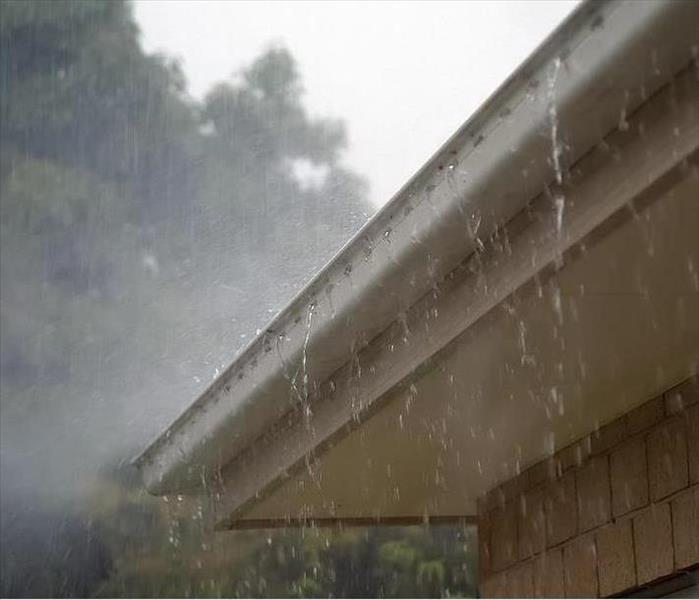 Overflowing rain gutters can possibly lead to water intrusion and other damage.
Overflowing rain gutters can possibly lead to water intrusion and other damage.
During a rainstorm, rain gutters route runoff from your roof to where it can drain away from the house. This helps protect siding, windows, doors, basements, and foundations from water damage. If the gutters are left unattended they become clogged with leaves and other debris. When this happens, the gutters fill up and water flows out over the sides. You should clean your gutters at least twice a year. You may have to clean them more often if your home is under a tree that sheds a large amount of leaves. Some people homeowners use gutter guards or leaf catchers, but they don’t always do the job.
Here are some tips for maintaining your rain gutters.
- Safety first, consider using gloves and eye protection
- Use a garden trowel to scoop out any dirt, leaves or other loose debris.
- A plumbing snake is a great for cleaning out the downspouts.
- A garden hose with a nozzle or wand will rinse out anything left behind.
- Take a good look to make sure the gutters are attached properly and not broken or cracked.
You never know when it’s going to rain, so stay ahead of the storm with a little preventive maintenance.
When it rains it pours in the San Fernando Valley.
6/5/2017 (Permalink)
It's not too often we get a large rain storm in the San Fernando Valley. But when we do, it's always more than we expect. Our Technicians at SERVPRO Of North Hollywood are qualified in storm and flood damage restoration. Our crews are highly trained and we use specialized equipment to restore your property to its pre-storm condition.
Since we are locally owned and operated, we are able to respond quicker with the right resources, which is extremely important. A fast response lessens the damage, limits further damage, and reduces the restoration cost.
When storms hit Southern California, we can scale our resources to handle a large storm or flooding disaster. We can access equipment and personnel from a network of over 1600 Franchises across the country and elite Disaster Recovery Teams that are strategically located throughout the United States.
We don't get very many rain storms in Southern California, but when it does happen, we are here to help.
 If you don't want your home to look like this, call SERVPRO NoHo for fast flood damage cleanup and restoration service in Los Angeles.
If you don't want your home to look like this, call SERVPRO NoHo for fast flood damage cleanup and restoration service in Los Angeles.






 24/7 Emergency Service
24/7 Emergency Service

















